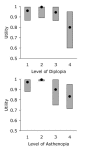The utility of strabismus in adults
Abstract
Purpose: To determine the utility (quality-of-life weight) associated with adult strabismus.
Methods: Time tradeoff utility values were measured in physician-conducted interviews with 140 adult patients with strabismus in a private practice setting. Patients also completed a questionnaire containing six items that rated the following aspects of disability: specific health problems, problems with tasks of daily living, problems with social interaction, self-image problems, concerns about the future, and job-related problems. Patients were characterized as presurgical or nonsurgical, and their diplopia and asthenopia were rated by the physician on a four-level scale.
Results: About 60% of all patients indicated willingness to trade part of their life expectancy in return for being rid of strabismus and its associated effects. The median utility was 0.93 (interquartile range, 0.83 to 1.0). A significantly smaller proportion (44%) of the nonsurgical patients (N = 41) appeared willing to trade time compared with surgical patients (68%; P = .009). Median utility in the presurgical patients was 0.90. Strong relationships were found between utility and the level of diplopia (P < .0001), and between utility and the level of asthenopia (P < .0001). Utility was correlated with all six disability ratings (all P < or = .00062).
Conclusion: A majority of the patients interviewed would trade a portion of their life expectancy in return for being rid of strabismus and its associated effects. These results were validated by significant associations with diplopia, asthenopia, and disability.
Figures



References
-
- Wortham E, 5th, Greenwald MJ. Expanded binocular peripheral visual fields following surgery for esotropia. J Pediatr Ophthalmol Strabismus. 1989;26:109–112. - PubMed
-
- Kushner BJ, Morton GV. Post-operative binocularity in adults with long-standing strabismus. Ophthalmology. 1992;99:316–319. - PubMed
-
- Ball A, Drummond GT, Pearce WG. Unexpected stereoacuity following surgical correction of long-standing horizontal strabismus. Can J Ophthalmol. 1993;28:217–220. - PubMed
-
- Morris RJ, Scott WE, Dickey CF. Fusion after surgical alignment of longstanding strabismus in adults. Ophthalmology. 1993;100:135–138. - PubMed
-
- Kushner BJ. Binocular field expansion in adults after surgery for esotropia. Arch Ophthalmol. 1994;112:639–643. - PubMed
MeSH terms
LinkOut - more resources
Full Text Sources
